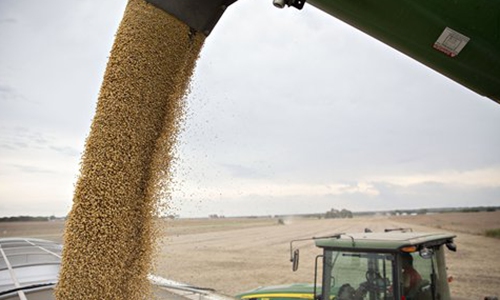Implementation of trade deal evident as China imported more from the US in August
Source: Global Times Published: 2020/9/7 14:38:59

Soybean Photo:Xinhua
China's foreign trade with its top trade partners increased during the first eight months of the year, while trade between China and the US declined. However, imports from the US surged and the trade surplus narrowed.
Analysts said the increased imports demonstrate that China is implementing the phase one trade deal with the US, and that the initiative will improve the environment for China-US economic and trade negotiations.
ASEAN remained China's biggest trading partner from January to August, accounting for 14.6 percent of China's total foreign trade. The EU took a share of 14 percent, and the US took 12.1 percent, followed by Japan's 7 percent.
Nevertheless, China's foreign trade with ASEAN, the EU and Japan increased, whilst that with the US declined.
"There must be some degree of substitution among the top four trading partners, and trade between China and the US may shift to other trading partners," Hu Qimu, a senior fellow at the Sinosteel Economic Research Institute, told the Global Times on Monday.
Foreign trade with the US, China's third largest trading partner, was 2.42 trillion yuan ($354.3 billion) from January to August, down 0.4 percent on a yearly basis. Among which, China's exports to the US were 1.87 trillion yuan, down 0.5 percent, as imports from the US reached 549.32 billion yuan, up 0.2 percent, narrowing the trade surplus by 0.8 percent to 1.32 trillion yuan.
"Overall commodity prices this year are lower than last year, which is just more evidence that China is importing more from the US," Hu noted.
Hu said that the decline in Chinese export volume is partly down to the impact of the COVID-19 epidemic this year; partly because China has taken the initiative to adjust the China-US trade balance; and partly due to the exchange rate. In addition, export commodities in China are quoted in US dollars, and the dollar index has weakened this year, reducing its value in yuan terms.
China imported 64.739 million tons of soybeans in the first eight months of the year, an increase of 15 percent year-on-year.
Analyst said the China-US trade deal has contributed to the increase of soybean imports, but also partly due to the fact that soybean imports have actually maintained positive annual growth for several years.
It is expected that imports from the US will continue to increase in the fourth quarter, because North American soybeans started to come on the market in the second half of the year, while China mainly bought South American beans in the first half, said Hu.
According to the US Department of Agriculture, soybean production in August increased 24.6 percent to 4.42 billion bushels (120 million tons) from the previous season.
China's foreign trade reached 2.88 trillion yuan in August, up 6 percent year-on-year, and trade in the first eight months was 20.05 trillion yuan, down 0.6 percent from the previous year. The trade surplus, 2.05 trillion yuan, increased 17.2 percent year-on-year, according to statistics released on Monday by the General Administration of Customs.
RELATED ARTICLES:
Posted in: ECONOMY